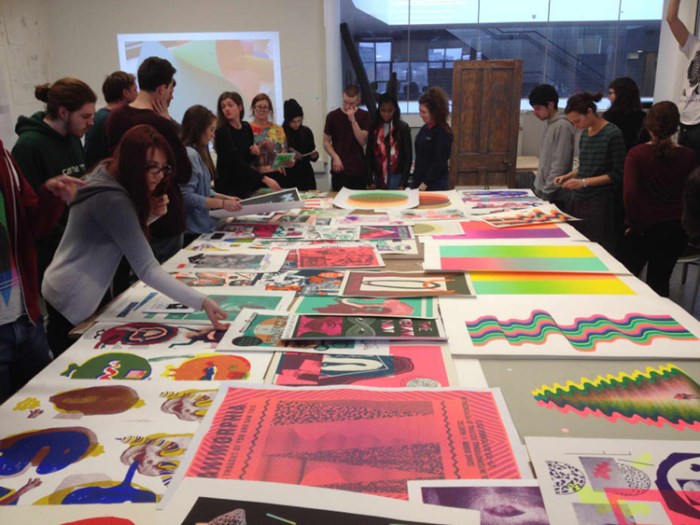Embark on a journey into the realm of design education, where creativity meets academic rigor. Explore the esteemed institutions that nurture the next generation of graphic design visionaries, shaping the visual landscape of our world. From renowned faculty to cutting-edge facilities, discover the universities that ignite passion, foster innovation, and empower students to make an indelible mark on the industry.
In this comprehensive guide, we delve into the intricacies of choosing the ideal university for graphic design, examining key factors that influence success. We uncover specialized programs and concentrations that cater to diverse interests, empowering students to tailor their education to their unique aspirations.
Join us as we unveil the career paths that await graduates, from high-profile design agencies to entrepreneurial ventures, showcasing the boundless opportunities this dynamic field offers.
Top Universities for Graphic Design
Graphic design is a rapidly growing field that combines creativity, technology, and communication. As the demand for skilled graphic designers continues to rise, so does the importance of choosing the right university for your education. Here is a list of the top 10 universities for graphic design worldwide, based on their rankings, location, and notable alumni.
paragraphThese universities offer a variety of programs in graphic design, from undergraduate degrees to graduate degrees. They have experienced faculty, state-of-the-art facilities, and strong connections to the industry. Graduates from these universities go on to work for leading design firms, advertising agencies, and tech companies.
Top 10 Universities for Graphic Design
| Rank | University | Location | Notable Alumni ||---|---|---|---|| 1 | Rhode Island School of Design | Providence, Rhode Island, USA | Milton Glaser, Paula Scher, David Carson || 2 | School of Visual Arts | New York City, New York, USA | Ed Benguiat, Jessica Hische, Stefan Sagmeister || 3 | Parsons School of Design | New York City, New York, USA | Tom Ford, Marc Jacobs, Anna Sui || 4 | California Institute of the Arts | Valencia, California, USA | Ed Catmull, John Lasseter, Tim Burton || 5 | Pratt Institute | Brooklyn, New York, USA | Louise Fili, Paula Scher, Massimo Vignelli || 6 | Royal College of Art | London, United Kingdom | David Hockney, Tracey Emin, Anish Kapoor || 7 | University of the Arts London | London, United Kingdom | Vivienne Westwood, Alexander McQueen, Stella McCartney || 8 | Hochschule für Gestaltung Karlsruhe | Karlsruhe, Germany | Otl Aicher, Wolfgang Weingart, Wim Crouwel || 9 | École nationale supérieure des arts décoratifs | Paris, France | Jean Cocteau, Yves Saint Laurent, Christian Lacroix || 10 | University of Technology Sydney | Sydney, Australia | Ken Done, Lindy Lee, Ken Cato |
Factors to Consider When Choosing a University for Graphic Design

Selecting the right university for graphic design is crucial for your future success in the field. Here are some key factors to consider:
Faculty Expertise:Research the faculty members' qualifications, experience, and areas of specialization. Look for professors who are actively involved in the industry and have a strong track record of teaching and mentoring students.
Curriculum
The curriculum should provide a comprehensive foundation in graphic design principles, including typography, color theory, composition, and software proficiency. It should also offer specialized courses in areas such as branding, motion graphics, and web design.
Facilities
Access to state-of-the-art facilities is essential. Look for universities with modern computer labs, printing and production equipment, and dedicated design studios.
Industry Connections
Strong industry connections can provide valuable opportunities for internships, networking, and career placement. Consider universities that have partnerships with design firms, agencies, and industry professionals.
Specialized Programs and Concentrations
Graphic design degrees often offer specialized programs and concentrations to cater to students' specific interests and career aspirations. These programs provide in-depth knowledge and skills in particular areas of graphic design, enabling students to develop expertise and build a competitive edge in the industry.
Some common specialized programs and concentrations include:
Branding
- Focuses on the creation and management of brand identities, including logos, brand guidelines, and marketing materials.
- Students learn about brand strategy, market research, and visual communication techniques.
Typography
- Specializes in the art and technique of arranging typefaces to create visually appealing and effective designs.
- Students study typography principles, font selection, and typographic hierarchy.
Motion Graphics
- Involves the creation of animated graphics for various platforms, such as websites, social media, and television.
- Students learn about animation techniques, motion principles, and software applications.
Career Paths for Graphic Designers
Graphic designers enjoy a wide range of career opportunities in diverse industries. Their skills are highly sought after in various fields, leading to a multitude of job titles and earning potentials.
Graphic designers may specialize in specific areas such as web design, branding, or illustration, catering to the unique needs of various industries.
Web Designers
- Design and develop websites, ensuring optimal user experience and visual appeal.
- Collaborate with developers to integrate design elements into functional websites.
Brand Designers
- Create and manage brand identities, including logos, color palettes, and typography.
- Develop marketing materials, packaging, and other brand-related collateral.
Illustrators
- Create visual representations of ideas, concepts, and stories for various media.
- Specialize in digital or traditional illustration techniques, such as drawing, painting, or photography.
Earning Potential
The earning potential for graphic designers varies depending on factors such as experience, skill level, industry, and location. According to the U.S. Bureau of Labor Statistics, the median annual salary for graphic designers in May 2021 was $56,250. The top 10% earned over $97,300, while the bottom 10% earned less than $34,320.
Notable Alumni and Their Impact

The top graphic design universities have produced many notable alumni who have made significant contributions to the field. These alumni have gone on to become successful designers, educators, and leaders in the industry.
One notable alumnus is David Carson, who graduated from the Rhode Island School of Design. Carson is known for his experimental and innovative work, which has pushed the boundaries of graphic design. He has worked for clients such as Nike, Pepsi, and MTV, and his work has been featured in numerous publications.
Other notable alumni include:
- Paula Scher (Cooper Union)
- Milton Glaser (Cooper Union)
- Stefan Sagmeister (Pratt Institute)
- Jessica Walsh (RISD)
- Michael Bierut (Yale University)
These are just a few of the many notable alumni who have graduated from top graphic design universities. These alumni have made significant contributions to the field and have helped to shape the way that we think about graphic design today.
End of Discussion

As we conclude our exploration of the best universities for graphic design, let us remember that the choice of institution is a transformative decision. It is a gateway to a world of creative possibilities, where students can refine their skills, ignite their imagination, and forge connections that will shape their professional journeys.
Whether aspiring to become masters of typography, branding experts, or motion graphics pioneers, these universities provide the foundation for excellence in the ever-evolving realm of visual communication.
Key Questions Answered
What factors should I consider when choosing a university for graphic design?
Consider faculty expertise, curriculum relevance, state-of-the-art facilities, industry connections, and alumni success.
What specialized programs and concentrations are available in graphic design?
Programs may specialize in areas such as branding, typography, motion graphics, user experience design, and web design.
What career paths can I pursue with a degree in graphic design?
Graduates can work as graphic designers, art directors, creative directors, user experience designers, and web designers in various industries.




